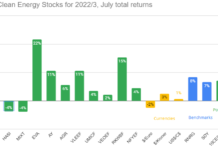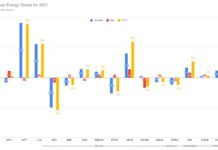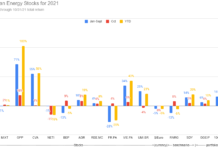Tom Konrad Ph.D., CFA
In the two months since the last update, most of the stocks in my Ten Clean Energy Stocks model portfolio have reported first quarter earnings. There were few surprises, and those were mostly pleasant ones, allowing the model portfolio to add to its gains, and pull a little farther ahead of its benchmark.
For the year to the end of May, the model portfolio is up 13.8%, 2% ahead of its benchmark. The benchmark is an 80/20 blend of the clean energy income benchmark (the Yieldco ETF YLCO) and the clean energy growth benchmark (Clean Energy ETF PBW), with the ratio matching the 80/20 mix of income and growth stocks in the model portfolio.
The 8 income stocks again led the pack, with an average total return of 15.2% for the year to date. The Green Global Equity Income Portfolio (GGEIP), an income and green focused strategy I manage also did well, up 13.5%. For comparison, the income benchmark YLCO produced a solid 11.4% return.
The two growth stocks recovered from losses early in the year and are now up 9.4%, but still behind PBW at 12.9%.

I
Stock discussion
Income Stocks
Pattern Energy Group (NASD:PEGI)
12/31/16 Price: $18.99. Annual Dividend: $1.63 (8.6%). Expected 2017 dividend: $1.64 to $1.67. Low Target: $18. High Target: $30.
5/31/17 Price: $22.56. YTD Dividend: $0.408 (2.2%). Annualized Dividend: $1.655. YTD Total Return: 21.2%
Wind-focused Yieldco Pattern Energy Group advanced in strongly in April ahead of first quarter earnings. Earnings did not disappoint, and the Yieldco added to those gains in May. Guidance for 2017 Cash Flow Available for Distribution (CAFD) is $140 to $165 million, which would be 5% to 24% increase on 2016 CAFD.
Growth has been slowing for Pattern, mainly because the low share price following the Yieldco bust at the end of 2015 has prevented the company from raising much equity capital. I expect that the share price will need to rise into the high 20s before we see large equity issuance from Pattern. With lower growth, they are also lowering their quarterly dividend increases. Since the IPO in 2014, the average quarterly increase has been 2.7%, but the company only increased its dividend 2% in the fourth quarter of 2016 and 1.4% this quarter. This lower rate of increases seems prudent, given that CAFD may only grow 5% this year at the low end.
Less prudent in a time when the company needs to be careful with its cash is the Yeildco’s consideration of an investment in the early stage projects of its parent, Pattern Development. In general, I think it is a good idea for Yieldcos to invest in project development with some of their resources, and eventually, as they grow larger, do much of their project development in house. That said, the time to invest in relatively risky but potentially high return businesses is when the stock is highly valued. When money is tight, as it is now for Patten and most other Yieldcos, it’s best to focus on investments that will increase the dividend in the short term. The time to invest in Pattern Development will be after the stock price recovers. Even small investments in early stage projects like the one being considered will only delay further stock price recovery.
8point3 Energy Partners (NASD:CAFD)
12/31/16 Price: $12.98. Annual Dividend: $1.00 (7.7%). Expected 2017 dividend: $1.00 to $1.05. Low Target: $10. High Target: $20.
5/31/17 Price: $13.64. YTD Dividend: $0.257 (2.0%) Annualized Dividend: $1.028. YTD Total Return: 7.1%
I took a deeper look at Solar-only Yieldco 8point3’s plans to refinance its company level debt with amortizing debt in March. The company abandoned these plans April when one of its sponsors, First Solar (FSLR), announced that it was considering selling its stake in the Yieldco.
While I believe the refinancing plans were prudent, I found that they would have reduced 8point3’s CAFD below the level needed to sustain its current dividend. To make matters worse, the Yieldco announced a dividend increase while the refinancing plans were still in place. This behavior basically meant that 8point3 was hoping that its unsustainable dividend increases would cause investors to buy the stock and drive up the stock price. This hoped-for stock rebound would allow 8point3 to make new investments and increase cash flow enough to avoid a dividend cut.
In short, 8point3 was acting like it expected a return to the Yieldco bubble of 2014 and early 2015.
The abandonment of 8point3’s (prudent) plans to refinance its company-level interest only debt with project-level amortizing debt leaves sufficient cash flow to pay its current dividend, but does not address the reason for that plan in the first place. 8point3’s debt matures in 2020, and it is an open question if lenders will be willing to refinance it at comparable terms. If the stock price recovers, the company will issue new equity and grow itself out of the problem. If not, the only option open to 8point3 in 2019 may be refinancing with project level, amortizing debt. That will greatly reduce CAFD, leading to a large dividend cut. The company’s recent dividend increases only make this future problem worse.
This strategy of hoping that the stock market will bail the company out of its financing problems, at the same time as one (if not both) of its sponsors are looking for the exits is, in my opinion, irresponsible corporate management. While the high yield puts a floor on the stock price in the near term, I believe that long term investors are becoming increasingly skeptical of the company. This skepticism should also put a ceiling on the share price, and prevent management’s hopes of a share price recovery from coming to fruition.
As the maturity of 8point3’s debt moves closer, the consequences of the inevitable refinancing will loom larger in investors’ minds. I don’t know when it will happen, but at some point, the stock price will have to drop to reflect 8point3’s much lower expected CAFD and dividend after refinancing.
Because of this, I have started selling short calls on the stock, in order to profit from my prediction that the share price is likely to be capped in the near term, and fall in the medium term.
Hannon Armstrong Sustainable Infrastructure (NYSE:HASI).
12/31/16 Price: $18.99. Annual Dividend: $1.32 (7.0%). Expected 2017 dividend: $1.34 to $1.36. Low Target: $15. High Target: $30.
5/31/17 Price: $21.91. YTD
Dividend: $0.33 (1.7%). Annualized Dividend: $1.32. YTD Total Return: 17.1%
In my last update, I said that Hannon Armstrong’s recent secondary stock offering had depressed the stock and that the then current price of $19.20 represented a buying opportunity. The stock of this sustainable infrastructure financier has since risen 14%. The dividend is still attractive and it still has plenty of room for gains, but is no longer a screaming deal.
The first quarter earnings release was admirably boring, showing steady growth.
NRG Yield, A shares (NYSE:NYLD/A)
12/31/16 Price: $15.36. Annual Dividend: $1.00 (6.5%). Expected 2017 dividend: $1.00 to $1.10. Low Target: $12. High Target: $25.
5/31/17 Price: $17.20. YTD Dividend: $0.53. Annualized Dividend: $1.08. YTD Total Return: 15.5%
Yieldco NRG Yield (NYLD and NYLD/A) had a mixed quarter, with improved availability of its wind and solar assets, offset by unfavorable weather. It does not matter how well your solar plant is running if it does not stop raining. The company’s conventional fleet also had problems with forced outages, although some of the losses were recovered through insurance.
These problems were mostly offset by new acquisitions. Although, like many Yieldcos, NRG Yield’s share price has been depressed, its stock price has been recovering and it is able to raise some equity capital to accretively invest in new projects. It also has $144 million in availability from its existing borrowing facilities. This growth potential means that the Yeildco is still on track to raise its dividend by 15% in 2017 over the previous year.
Nor should it lack for projects to buy. In addition to its identified ROFO list, its parent NRG is under pressure to sell its renewable businesses from an activist shareholder. This might lead to accelerated purchases of some assets at better-than-expected prices.
Atlantica Yield, PLC (NASD:ABY)
12/31/16 Price: $19.35. Annual Dividend: $0.65 (3.4%). Expected 2017 dividend: $0.65 to $1.45. Low Target: $10. High Target: $30.
5/31/17 Price: $20.89. YTD Dividend: $0.25 (2.6%). Annualized Dividend: $1.00. YTD Total Return: 10.6%
Atlantica Yield continues to impress me, but not the market. Along with first quarter earnings, the company announced that it had “obtained a waiver in Kaxu which waives any past potential cross-default with Abengoa in the project finance agreement.” After Kaxu, the company needs to obtain only one more such waiver in order to free itself from the after-effects of its former parent Abengoa’s bankruptcy.
The remaining project, ACT, represents 300 MW of conventional power generation in Mexico, and accounted for 13% of revenue in 2016. The muted reaction of investors to first quarter earnings may have been in response to the company’s decision not to raise the dividend until it obtains the final waiver for ACT. Given ACT’s share for revenue and cash flow, the board could have easily justified increasing the quarterly dividend to $0.30. The fact that they chose to keep the dividend at $0.25 is the exact opposite of the “raise the dividend and hope investors come” strategy that concerns me at 8point3 Energy Partners (see above.)
Contrasting Atlantica and 8point3
In sharp contrast to 8point3, Atlantica is preserving corporate capital and using it to make small investments which will lead to long term dividend growth, such as the $10 million investment in a California-Arizona transmission line announced in the first quarter.
Like all income investors, I like dividend increases, but I like prudent uses of capital even more. With Yieldco stocks still out of favor, it’s much better to fund growth with retained cash flow as Atlantica is doing than to squander current resources in the hope that the stock price will recover and shareholders will be willing to fund today’s dividend increase after it has already happened.
Another telling point of contrast between Atlantica and 8point3 is Atlantica’s stated 3x target for the ratio of corporate level debt to pre-debt service CAFD. For Atlanica, this ratio stood at a cautious 2.6 at the end of the first quarter. 8point3 does not use (or at least disclose) this ratio, but we can estimate it. For 2017, 8point3 is projecting approximately $95 million of CAFD and $25 million of debt service. All $714 million debt is corporate level, so 8point3’s outlook puts the same ratio at just below 6- twice Atlantica’s target.
The point of a ratio like this is to ensure that changes in the cost of servicing corporate debt will have a limited impact on dividends. 8point3 is currently paying 3.5% per year for debt service. This must be refinanced by 2020. If it is all refinanced at the same 5% rate as Atlantica just refinanced some of their corporate level interest-only debt, the annual debt service cost will rise from $25 million to $36 million, reducing annual CAFD to $80 million, or $1 per share.
Even this is a best-case scenario that assumes no the company can refinance everything with interest only debt. If 8point3 tried to meet Atlanitca’s 3 times target, it would need to refinance more than half of its debt with amortizing project level debt, annual CAFD would fall to $0.88 a share. That puts the current dividend rate of $1.08/year at 123% of 8point3’s long term sustainable CAFD. This ratio of dividends to CAFD is called the payout ratio, and most Yieldcos target payout ratios of 80% to 90%. Atlantica’s target payout ratio is 80%, and its current dividend of $0.25 per quarter is only 56% of CAFD guidance for 2017. This leaves a lot of room for Atlantica to increase its dividend later this year.
NextEra Energy Partners (NYSE:NEP)
12/31/16 Price: $25.54. Annual Dividend: $1.36 (5.3%). Expected 2017 dividend: $1.38 to $1.50. Low Target: $20. High Target: $40.
5/31/17 Price: $34.54. YTD Dividend: $0.718 (2.8%). Annualized Dividend: $1.46. YTD Total Return: 21.9%
NextEra Energy Partners also compares favorably with other Yieldcos on measures such as payout ratio and company level debt. Its outlook for long term CAFD from its current properties is approximately $310-340 million, or $2 to $2.20 per share, compared to 2017 distributions of $1.58-$1.62 per share. That gives a payout ratio of around 80%.
Management does not plan not to issue additional equity until the share price recovers. If the share price does not recover, the company may have trouble delivering on it 5 year dividend growth target of 12% to 15% per year, but not until at least 2019, and there is no danger of a dividend cut like the one we could see for 8point3 in the same time frame. And in Nextera Energy Partners’ case, the necessary share price recovery is already underway.
Other Income Stocks
Covanta Holding Corp. (NYSE:CVA)
12/31/16 Price: $15.60. Annual Dividend: $1.00 (6.4%). Expected 2017 dividend: $1.00 to $1.06. Low Target: $10. High Target: $30.
5/31/17 Price: $14.75. YTD Dividend: $0.25 (1.6%) Annualized Dividend: $1.00. YTD Total Return: -3.9%
Along with Atlantica, waste-to-energy developer and operator Covanta continues to suffer because of market weakness in power prices and commodity metals. Earnings were significantly negative at -$0.41 per share, but like Yieldcos, much of this loss is in the form of depreciation, and so it does not have much bearing on the company’s ability to maintain its dividend. The company’s Free Cash Flow guidance for 2017 is $100 million to $150 million, which should be sufficient to maintain its $129 million in annual dividend payments until cash flow increases because of growth investments or recovering commodity markets.
The company’s Dublin facility accepted its first waste delivery and remains on track for commercial operation in the fourth quarter of this year.
Seaspan Corporation, Series G Preferred (NYSE:SSW-PRG)
12/31/16 Price: $19.94. Annual Dividend: $2.05 (10.3%). Expected 2017 dividend: $2.05. Low Target: $18. High Target: $27.
5/31/17 Price: $21.22. YTD Dividend: $1.023 (5.1%). Annualized Dividend: $2.05. YTD Total Return: 11.3%
Leading independent charter owner of container ships had a very bullish first quarter earnings report, noting that the weakness in pricing container ship leases seemed to have hit bottom. Other shipping companies, such as Maersk (MAERSK-B.CO) have noted similar improvements. Despite this, the company’s common stock continued to drop in May, and its preferred stock (such as SSW-PRG) has not delivered significant gains. I think this makes now a particularly good time to buy the company’s preferred shares, or even speculate on a sharp recovery of the common stock. I did both in recent weeks, buying a little of both the preferred E and H series shares, and buying some long dated $7.5 calls on the common stock as it temporarily fell to near $5.
Growth Stocks
MiX Telematics Limited (NASD:MIXT).
12/31/16 Price: $6.19. Annual Dividend: $0.14 (2.3%). Expected 2017 dividend: $0.14 to $0.16. Low Target: $4. High Target: $15.
5/31/17 Price: $7.12. YTD Dividend: $0.037 (0.6%). Annualized Dividend: $0.14. YTD Total Return: 9.5%
Everything seems to be coming together for vehicle and fleet management software as a service provider MiX Telematics. For the last 2-3 quarters, we’ve been seeing renewed growth in subscriptions in most of the company’s segments. Subscription revenue came in ahead of guidance for the fourth quarter and fiscal year ending March 31st.
The recovery of oil prices to around $50 a barrel has led to a rapid increase in activity should lead to renewed growth in subscriptions MiX’s oil and gas customers. This segment was a drag on MiX’s results in 2016, but should continue to be a tailwind for the rest of this year.
Aspen Aerogels (NYSE:ASPN)
12/31/16 Price: $4.13. Annual Dividend and expected 2017 dividend: None. Low Target: $3. High Target: $10.
5/31/17 Price: $4.52. YTD Total Return: 9.4%
As I expected, Aspen Aerogels delivered unimpressive first quarter earnings. What I did not expect was that the stock would rally for no reason I could see other than a good long term valuation even if the near term prospects still seem weak. When a stock falls for no reason I can determine, I usually buy. When it rises, as Aspen did, I remain on the sidelines.
Final Thoughts
Although the world political and economic climate remains volatile, the US stock market has remained calm so far this year. How long that can continue is anyone’s guess, but I think defensive investments like cash, attractively valued income stocks, and real income investments like home solar remain the best places to put your money.
On home solar, I recently published an article comparing it as an investment to commonly held mutual funds. Spoiler: the mutual funds did not fare well. For defensive income stocks, Atlantica Yield, Covanta, and Seaspan Preferred shares are all looking very attractive right now. As for cash, keep some around. I suspect we will see some much better valuations in the stock market over the next 6 months to a year.
Disclosure: Long HASI, MIXT, PEGI, NYLD/A, CVA, ABY, NEP, SSW-PRG, ASPN, GLBL, TERP. Long puts on SSW (an effective short position held as a hedge on SSW-PRG. Short calls on CAFD.)
DISCLAIMER: Past performance is not a guarantee or a reliable indicator of future results. This article contains the current opinions of the author and such opinions are subject to change without notice. This article has been distributed for informational purposes only. Forecasts, estimates, and certain information contained herein should not be considered as investment advice or a recommendation of any particular security, strategy or investment product. Information contained herein has been obtained from sources believed to be reliable, but not guaranteed.







